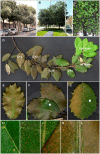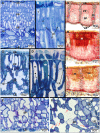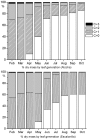Foliar symptoms triggered by ozone stress in irrigated holm oaks from the city of Madrid, Spain
- PMID: 23894424
- PMCID: PMC3718789
- DOI: 10.1371/journal.pone.0069171
Foliar symptoms triggered by ozone stress in irrigated holm oaks from the city of Madrid, Spain
Abstract
Background: Despite abatement programs of precursors implemented in many industrialized countries, ozone remains the principal air pollutant throughout the northern hemisphere with background concentrations increasing as a consequence of economic development in former or still emerging countries and present climate change. Some of the highest ozone concentrations are measured in regions with a Mediterranean climate but the effect on the natural vegetation is alleviated by low stomatal uptake and frequent leaf xeromorphy in response to summer drought episodes characteristic of this climate. However, there is a lack of understanding of the respective role of the foliage physiology and leaf xeromorphy on the mechanistic effects of ozone in Mediterranean species. Particularly, evidence about morphological and structural changes in evergreens in response to ozone stress is missing.
Results: Our study was started after observing ozone -like injury in foliage of holm oak during the assessment of air pollution mitigation by urban trees throughout the Madrid conurbation. Our objectives were to confirm the diagnosis, investigate the extent of symptoms and analyze the ecological factors contributing to ozone injury, particularly, the site water supply. Symptoms consisted of adaxial and intercostal stippling increasing with leaf age. Underlying stippling, cells in the upper mesophyll showed HR-like reactions typical of ozone stress. The surrounding cells showed further oxidative stress markers. These morphological and micromorphological markers of ozone stress were similar to those recorded in deciduous broadleaved species. However, stippling became obvious already at an AOT40 of 21 ppm•h and was primarily found at irrigated sites. Subsequent analyses showed that irrigated trees had their stomatal conductance increased and leaf life -span reduced whereas the leaf xeromorphy remained unchanged. These findings suggest a central role of water availability versus leaf xeromorphy for ozone symptom expression by cell injury in holm oak.
Conflict of interest statement
Figures










References
-
- Paoletti E (2006) Impact of ozone on Mediterranean forests: A review. Environ Pollut 144: 463–474. - PubMed
-
- EEA (2003) Air pollution by ozone in Europe in summer 2003. Overview of exceedances of EC ozone threshold values during the summer season April- August 2003 and comparisons with previous years. Copenhagen: European Environment Agency Topic report No 3/2003.
-
- EEA (2005) Air pollution by ozone in Europe in summer 2004. Overview of exceedances of EC ozone threshold values for April–September 2004. Copenhagen: European Environment Agency Technical report No 3/2005.
-
- EEA (2006) Air pollution by ozone in Europe in summer 2005. Overview of exceedances of EC ozone threshold values for April–September 2005. Copenhagen: European Environment Agency Technical report No 3/2006.
Publication types
MeSH terms
Substances
LinkOut - more resources
Full Text Sources
Other Literature Sources
Medical

